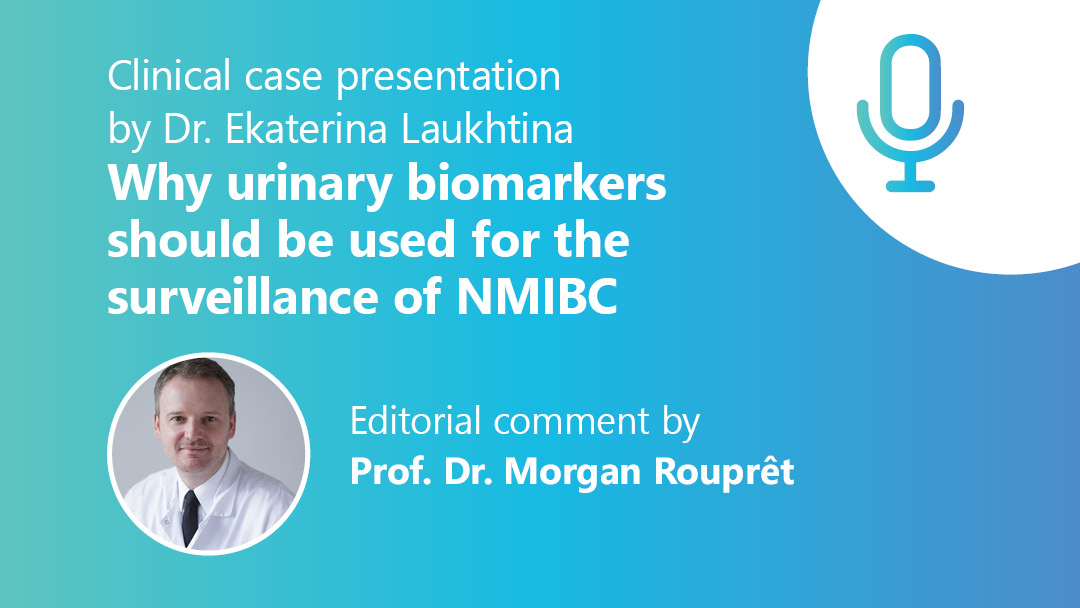Clinical case presentation by Dr. Ekaterina Laukhtina (Moscow, Russia)
Editorial comment by Morgan Rouprêt
The implementation and advantages of urinary biomarkers for non-muscle-invasive-bladder (NMIBC) were discussed by an international expert panel at the 19th Meeting of the EAU Section of Oncological Urology (ESOU22), held on 21-23 January 2022 in Madrid, Spain.
The panel consisted of Prof. Morgan Rouprêt (Paris, France), Prof. Fred Witjes (Nijmegen, The Netherlands), Dr. Mario Álvarez-Maestro (Madrid, Spain) and Dr. Luis Martínez-Piñeiro (Madrid, Spain).
Dr. Ekaterina Laukhtina presented a case study of an 82-year-old NMIBC patient who underwent a transurethral resection of bladder tumour (TURBT). The pathology report indicated papillary pTa low-grade urothelial carcinoma, no lymphovascular invasion.
Dr. Laukhtina raised the question to the expert panel whether non-invasive urinary biomarkers could be routinely used to avoid cystoscopy during surveillance of this patient.
Dr. Mario Álvarez-Maestro replied that he has a very good experience with Bladder EpiCheck® and UroMonitor® in patients with low-grade tumours. He recommends using a urinary biomarker in elderly patients and not to perform a cystoscopy when the result of the test is negative.
Prof. Fred Witjes, agreed with Dr. Mario Álvarez-Maestro and added that urinary biomarkers became very popular during the COVID-19 pandemic as patients were not allowed or reluctant to come to the hospital. A urine sample can simply be collected and shipped from home to the laboratory and the result can be discussed during a teleconsultation. Prof. Fred Witjes uses Bladder EpiCheck® in clinical practice, which performs very well in excluding high-grade tumours, in all patients regardless of tumour grade history.
An important remark was made by Prof. Morgan Rouprêt, who noted that urinary markers are currently not recommended for routine use and consequently, not reimbursed. However, alternating a urinary biomarker with cystoscopy in clinical practice is cost effective according to Prof. Fred Witjes, who learned this from practices at his hospital. Especially in an era of COVID-19 outbreak when patients were reluctant to come to the hospital.
Dr. Mario Álvarez-Maestro pointed out that patients should be properly informed: if you have a negative result, the probability of not having a bladder tumour is 90%.
Which urinary biomarker test to use?
Several urinary biomarkers are currently available on the market who differ in the technology (e.g. protein-based, DNA methylation-based) and for whom no head-to-head comparison is available, which can make the choice of marker difficult.
Dr. Mario Álvarez-Maestro and Prof. Fred Witjes both started using the Bladder EpiCheck® because of obvious reasons (participation in a clinical trial with Bladder EpiCheck®, first one available at the hospital), but decided to continue using this marker because they know how to use it, and it performs well.
Dr. Alberto Breda (Barcelona, Spain) from the audience pointed out DNA methylation-based tests such as the Bladder EpiCheck® are the best according to literature. Additionally, Bladder EpiCheck® uses 15 DNA methylation biomarkers, while other tests only use 2-3 makers, resulting in a high NPV and sensitivity for Bladder EpiCheck®.
What if the patient refuses cystoscopy in follow-up?
In the case study presented by Dr. Ekaterina Laukhtina, the patient refused cystoscopy after 12 months of regular follow-up with cystoscopy, cytology, and a urinary biomarker. In this situation, Dr. Mario Álvarez-Maestro would prefer a urinary biomarker together with cytology.
At 24 months of follow-up, cytology was negative, while the urinary biomarker test was positive. Subsequent cystoscopy showed a 1 cm papillary tumour suggestive of low risk. Due to the age and comorbidities of the patient, active surveillance (cystoscopy + cytology) was chosen as the next step.
Share this on your favourite network:

